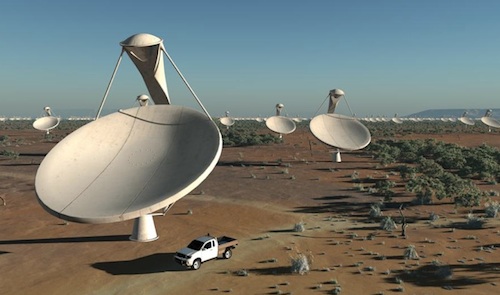A remote spot in SA’s Karoo desert has taken a first step towards hosting one of the most powerful scientific instruments in history, to shed light on how the universe began.
Driving the dirt road to the Karoo Array Telescope site, the FM radio searches in vain for a frequency it can catch, scanning the dial bottom to top and back again.
This very quiet corner of SA’s sparsely populated Northern Cape province seems an unlikely place to build such an instrument, but its silence is precisely what makes the Karoo an attractive site for the Square Kilometre Array (SKA) telescope project.
Scientists hope the SKA, a massive new radio telescope linking 3 000 antenna dishes, will shed new light on fundamental questions about the universe, including how it began, why it’s expanding and whether it contains life beyond our planet.
To do that, the SKA will need a quiet radio spectrum, clear skies, high altitude and low seismic activity, according to Albert van Jaarsveld, president of the National Research Foundation, which is helping mount the country’s bid to build the ultra-powerful new telescope.
“The remoteness of this location is its strength and not its weakness,” Van Jaarsveld told journalists Tuesday on a visit to the proposed site.
SA is competing with Australia to win the contract for the SKA, a multibillion-dollar instrument that will be 50 times more sensitive than today’s most powerful radio telescopes.
The countries are the last two candidates in a five-year competition that has seen an international steering committee narrow the field from five proposals to two.
SA, which plans to spend R234m on the project by 2015, has built seven antenna dishes and recently linked two of them together, the first time a multi-receptor radio telescope has been tested, officials said Tuesday.
Van Jaarsveld said the test puts SA ahead of Australia in the race for the SKA.
If SA wins the bidding, engineers will connect antennas in the arid Karoo region by remote link to a network of dishes stretching across southern and eastern Africa and as far away as Ghana.
Australia’s bid puts the core site at Mileura station, about 100km west of Meekathara in western Australia. Other antennas would be distributed across Australia and New Zealand.
The SKA steering committee, which represents a consortium of 17 countries involved in the project, is expected to make its final decision in 2012.
Scientists hope when the SKA is complete — sometime around 2021 – it will pick up radio waves emitted by the first stars and galaxies to emerge from the big bang that created the universe.
It will also trace the effects of the so-called dark energy that is driving the universe apart and hunt for Earth-like planets orbiting other stars.
SA officials hope the project will help make the country a hub of scientific activity and reverse the “brain drain” that has seen Africa lose much of its top scientific talent to the rest of the world.
“If we succeed in bringing the SKA to Africa, it will be a major catalyst for the development of science and technology on our continent,” said science & technology minister Naledi Pandor.
“I can tell you from speaking to scientists and academics regularly that unless we have the facilities that make the study of science attractive, we will not keep scientists in our country,” she said.
“Through this project, what we’ve begun to do is reverse the brain drain.” — Sapa-AFP
- Subscribe to our free daily newsletter
- Follow us on Twitter or on Facebook


